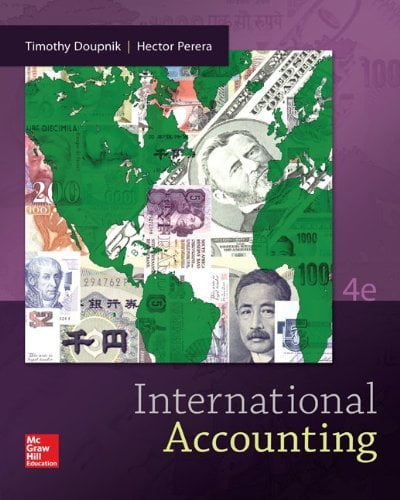International Accounting Doupnik 4th Edition Solutions Manual

Product details:
- ISBN-10 : 0077862201
- ISBN-13 : 978-0077862206
- Author: Timothy S. Doupnik, Hector B. Perera
The Fourth Edition of International Accounting provides an overview of the broadly defined area of international accounting, but also focuses on the accounting issues related to international business activities and foreign operations. This edition also includes substantially updated coverage of the International Accounting Standards Board (IASB) and International Financial Reporting Standards (IFRS).
The unique benefits of this textbook include its up-to-date coverage of relevant material, extensive numerical examples provided in most chapters, two chapters devoted to the application of International Financial Reporting Standards (IFRS), and coverage of nontraditional but important topics such as strategic accounting issues of multinational companies, international corporate governance, and corporate social responsibility reporting.
Description:
CHAPTER 1
INTRODUCTION TO INTERNATIONAL ACCOUNTING
Chapter Outline
I. International accounting is an extremely broad topic.
A. At a minimum it focuses on the accounting issues unique to multinational corporations, especially with respect to foreign operations.
B. At the other extreme it encompasses the study of the various functional areas of accounting in all countries of the world, as well as the activities of a number of supranational organizations.
C. Thisprovides an overview of the broadly defined area of international accounting, with a focus on the accounting issues encountered by multinational companies engaged in international trade and invested in foreign operations.
II. There are several accounting issues encountered by companies involved in international trade.
A. One issue is the accounting for foreign currency-denominated export sales and import purchases. An important issue is how to account for changes in the value of the foreign currency-denominated account receivable (payable) that occur as exchange rates fluctuate.
B. A related issue is the accounting for derivative financial instruments, such as forward contracts and foreign currency options, used to hedge the foreign exchange risk associated with foreign currency transactions.
III. There is an even greater number of accounting issues encountered by companies that have made a direct investment in a foreign operation. These issues primarily result from the fact that GAAP, tax laws, and other regulations differ across countries.
A. Figuring out how to make sense of the financial statements of a foreign acquisition target prepared in accordance with an unfamiliar GAAP when making a foreign direct investment decision.
B. Determining the correct amounts to include in consolidated financial statements for the assets, liabilities, revenues, and expenses of foreign operations. The consolidation of a foreign subsidiary involves a two-step process: (1) restate foreign GAAP financial statements into parent company GAAP and (2) translate foreign currency amounts into parent company currency. Determining the appropriate translation method and deciding how to report the resulting translation adjustment are important questions.
C. Complying with host country income tax laws, as well as home country tax laws related to income earned in a foreign country (foreign source income). Double taxation of income is a potential problem, and foreign tax credits are the most important relief from this problem.
D. Establishing prices for intercompany transactions that cross national borders (international transfer prices) to achieve corporate objectives and at the same time comply with governmental regulations.
E. Evaluating the performance of both a foreign operating unit and its management. Decisions must be made with respect to issues such as the currency in which a foreign operation should be evaluated and whether foreign management should be held responsible for items over which they have little control.
F. Establishing an effective internal audit function to help maintain control over foreign operations. Differences in culture, customs, and language must be taken into consideration.
G. Deciding whether to cross-list securities on foreign stock exchanges, and complying with local stock exchange regulations to do so. This could involve the preparation of financial information in accordance with a GAAP different from that used by the company.
IV. As companies have become more multinational, so have their external auditors. The Big 4 public accounting firms are among the most multinational business organizations in the world.
V. Problems encountered by MNCs when confronted with different local GAAP in different countries leads to the desire for accounting harmonization. There would be significant advantages to MNCs if all countries used the same GAAP.
VI. The world economy is becoming increasingly more integrated. International trade (imports and exports) has grown substantially in recent years and has become a normal part of business for relatively small companies. The number of U.S. exporting companies more than doubled in the 1990s.
VII. The tremendous growth in foreign direct investment (FDI) over the last two decades is partially attributable to the liberalization of investment laws in many countries specifically aimed at attracting FDI. The aggregate revenues generated by foreign operations are twice as large as the revenues generated through exporting.
VIII. There are more than 82,000 multinational companies in the world in 2009 with 810,000 foreign subsidiaries. The 100 largest multinationals generate approximately 4% of global GDP. A disproportionate number of multinational corporations are headquartered in the triad countries of the United States, Japan, and the European Union.
IX. The largest companies in the world are not necessarily the most multinational. Indeed, many large U.S. companies have no foreign operations. According to one definition of multinationality used by the United Nations, the two most multinational companies in the world in 2011 were based in Switzerland (Nestlé SA) and the United Kingdom (Anglo American plc).
X. In addition to establishing operations overseas, many companies also cross-list their shares on stock exchanges outside of their home country. There are a number of reasons for doing this including having access to a larger pool of capital.
Answers to Questions
1. In 2011, companies worldwide exported over $18.3 trillion worth of merchandise. Although international trade has existed for thousands of years, recent growth in trade has been phenomenal. Over the period 1996-2011, U.S. exports increased from $625 billion to $1,480 billion per year, a 137% increase. During the same period, Chinese exports increased eight-fold to $1,898 billion in 2011.
2. Companies engaged in international trade with imports and exports denominated in foreign currencies are faced with the accounting issue of translating foreign currency amounts into the company’s reporting currency and reporting the effects of changes in exchange rates in the financial statements.
3. As listed in Exhibit 1-1, following are several reasons why companies might want to invest overseas:
• Increase sales and profits
• Enter rapidly growing or emerging markets
• Reduce costs
• Gain an foothold in economic blocs
• Protect domestic markets
• Protect foreign markets
• Acquire technological and managerial know-how
4. FDI is playing a larger and more important role in the world economy. Global sales of foreign affiliates were about 1.5 times as high as global exports in 2011, compared to almost parity about three decades earlier. Global sales of foreign affiliates comprises about one tenth of worldwide gross domestic product.
5. Financial reporting issues that result from foreign direct investment are (a) conversion of foreign GAAP to parent company GAAP and (b) translation of foreign currency to parent company reporting currency to prepare consolidated financial statements. In addition, supplementary disclosures about foreign operations might be required.
6. Two major taxation issues related to a foreign direct investment are (a) taxation of the investee’s income by the host country in which the investment is located and (b) taxation of the investee’s income by the investor’s home country. Companies with foreign direct investments need to develop an expertise in the host country’s income tax rules so as to minimize the amount of taxes paid to the host country, as well as in the home country’s tax rules with respect to foreign source income.
7. Companies must make several decisions in designing the system for evaluating the performance of foreign operations. Two of these are (a) deciding whether to evaluate performance on the basis of foreign currency or parent company reporting currency and (b) deciding whether to factor out of the performance measure those items over which the foreign operation’s managers have no control.
8. Two reasons to have stock listed on the stock exchange of a foreign country are (a) to obtain capital in that country, perhaps at a more reasonable cost than is available at home, and (b) to have an “acquisition currency” for acquiring firms in that country through stock swaps.
9. The United Nations measures the multinationality of companies based on the average of three factors: the ratio of foreign sales to total sales, the ratio of foreign assets to total assets, and the ratio of foreign employees to total employees. Information about foreign sales, foreign assets, and the number of foreign employees might be provided in a company’s annual report or other publications through which a company provides information to the public.
10. A single set of accounting standards used worldwide would have the following benefits for multinational corporations:
• Reduce the cost of preparing consolidated financial statements
• Reduce the cost of gaining access to capital in foreign countries
• Facilitate the analysis and comparison of financial statements of competitors and potential acquisitions
Solutions to Exercises and Problems
1. Sony uses the following procedures to translate the foreign currency financial statements of its foreign subsidiaries into Japanese yen:
• All assets and liabilities are translated at the year-end exchange rate
• All income and expense accounts are translated at the exchange rate prevailing on the transaction date
• The resulting translation adjustment is included in accumulated other comprehensive income (stockholders’ equity)
[Students familiar with U.S. GAAP will recognize this approach as being procedures required by FASB Statement No. 52 for foreign subsidiaries with a foreign currency as their functional currency.]
Sony uses the following procedure to translate foreign currency payables and receivables into Japanese yen:
• All foreign currency receivables and payables are translated into Japanese yen at the year-end exchange rate
• Changes in the Japanese yen value of foreign currency receivables and payables are reported as gains and losses in income
[Students familiar with U.S. GAAP will recognize this as being the approach required in accounting for foreign currency payables and receivables.]
2. Sony has intercompany transactions that result in one affiliate paying foreign currency to (or receiving foreign currency from) another affiliate. The company uses foreign exchange forward contracts and foreign currency option contracts to fix the local currency value of the foreign currency that will be paid to (or received from) the affiliate. Sony does this for transactions that have already occurred (receivables and payables), as well as for transactions that are expected to occur (forecasted). For example, assume that Sony Mexico purchases goods from the parent company in Japan on February 1 with payment of 50 million Japanese yen to be made on March 31. Sony Mexico could enter into a two-month forward contract on February 1 that fixes the number of Mexican pesos it will need to pay to acquire 50 million Japanese yen on March 31. Alternatively, Sony Mexico could purchase a foreign currency option on February 1 that expires on March 31 that would give the company the option to purchase yen on that date at a predetermined price.
People also search:
international accounting doupnik
financial accounting 4th edition
|
international accounting 5th edition ebook |





